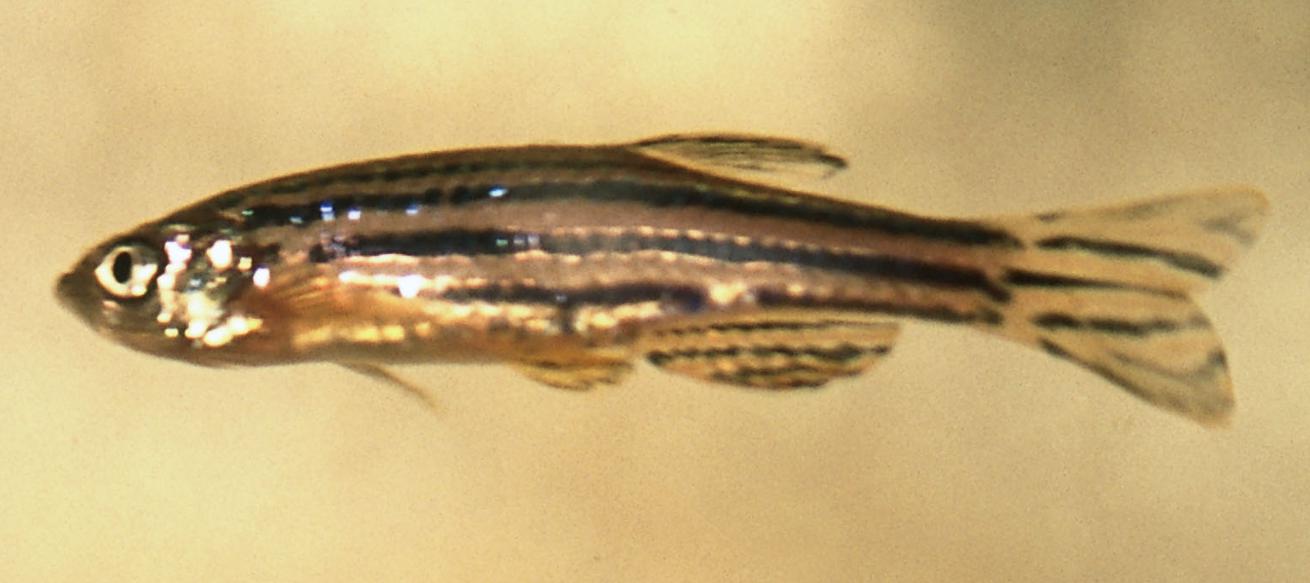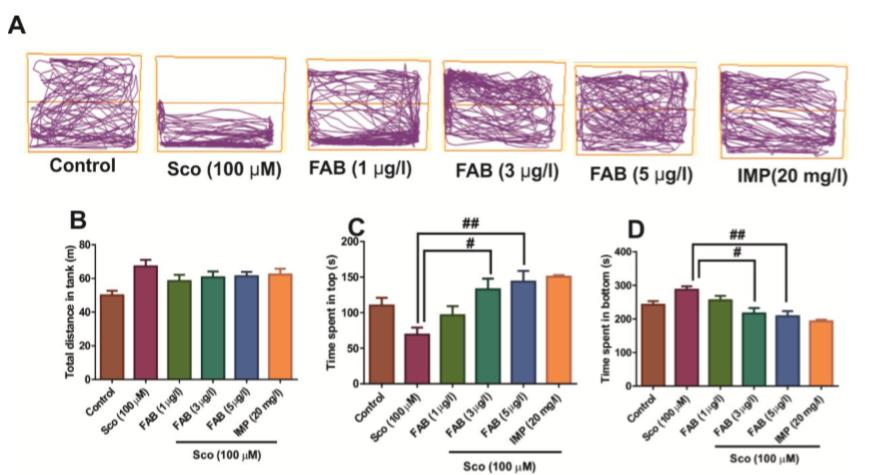Danio Rerio models
Danio rerio (zebrafish) have been used as a powerful tool in neuroscience research and drug screening due to their simple nervous system, small body size, feasible experimental manipulations as well as quantifiable behaviors. Importantly, many AD associated genes in Danio rerio are evolutionarily conservative compare to ours, including co-orthologues to PSEN1, PSEN2 and APP (Appa and Appb). GSK3β plays a crucial role in energy metabolism, apoptosis and cell motility and is abnormally up-regulated in AD pathogenesis. Inhibition of GSK3β activity has been viewed as a potential therapeutic approach for AD.
Creative Bioarray specializes in providing customized pharmacodynamic research services to help customers assess the efficacy of drug candidates and study the associated pathological mechanisms through Danio Rerio models.
 Figure. 1. Danio rerio
Figure. 1. Danio rerio
Creative Bioarray provides you with Danio Rerio models including but not limited to:
- Aβ induced Danio Rerio model
- Aluminum chloride induced Danio Rerio model
Our Capabilities
- We use Danio Rerio models to screen for drugs targeting GSK3β, cholinergic system and amyloid β-protein to treat AD.
- We provide Memory test on Danio Rerio models and the drug screening.
- We evaluate various biomarkers through WB, IHC, ELISA, sequencing, etc.
Assays available
- Memory test
- Synaptic impairment
- Oxidative stress
- Neuroinflammation
- Phosphorylated tau
- Glycogen synthase kinase-3 beta (GSK3β)
- Neurofilament Light Chain levels
- Enzyme activity related to cholinergic system
Creative Bioarray has years of experience in establishing Danio Rerio models. We also provide varieties of services including behavioral testing and molecular marker evaluation to meet your specific needs. We are confident to help you to overcome possible upcoming challenges in your research. With our help, we wish to facilitate your study with high efficiency.
Study examples
 Fig. 2. Agathisflavone (FAB, 1 µg/l, 3µg/l and 5 µg/l) improved locomotor pattern and decreased anxiety in the NTT test. (A) Representative locomotion tracking of the control, Scopolamine (100 µM), FAB (1 µg/l, 3µg/l and 5 µg/l) and IMP (20 mg/l) treated groups. (B) Represent total distance travelled by zebrafish in tank in different groups. (C) Represent the time spent by zebrafish in the top zone of the tank in different groups. (D) Represent the time spent by zebrafish in the bottom zone of the tank in different groups. Values are means ± S.E.M. (n = 20). For Turkey’s post hoc analyses: #Sco vs. FAB (3 µg/l): p<0.01 and ##Sco vs. FAB (5 µg/l): p<0.001.
Fig. 2. Agathisflavone (FAB, 1 µg/l, 3µg/l and 5 µg/l) improved locomotor pattern and decreased anxiety in the NTT test. (A) Representative locomotion tracking of the control, Scopolamine (100 µM), FAB (1 µg/l, 3µg/l and 5 µg/l) and IMP (20 mg/l) treated groups. (B) Represent total distance travelled by zebrafish in tank in different groups. (C) Represent the time spent by zebrafish in the top zone of the tank in different groups. (D) Represent the time spent by zebrafish in the bottom zone of the tank in different groups. Values are means ± S.E.M. (n = 20). For Turkey’s post hoc analyses: #Sco vs. FAB (3 µg/l): p<0.01 and ##Sco vs. FAB (5 µg/l): p<0.001.
Quotation and ordering
If you have any special needs or questions regarding our services, please feel free to contact us. We look forward to cooperating with you in the future.
Reference
- Dumitru G et al. Agathisflavone isolated from Schinus polygamus (Cav.) Cabrera leaves prevents scopolamine-induced memory impairment and brain oxidative stress in zebrafish (Danio rerio). Phytomedicine. 2019 May;58:152889
For research use only. Not for any other purpose.
Disease Models
- Oncology Models
-
Inflammation & Autoimmune Disease Models
- Rheumatoid Arthritis Models
- Glomerulonephritis Models
- Multiple Sclerosis (MS) Models
- Ocular Inflammation Models
- Sjögren's Syndrome Model
- LPS-induced Acute Lung Injury Model
- Peritonitis Models
- Passive Cutaneous Anaphylaxis Model
- Delayed-Type Hypersensitivity (DTH) Models
- Inflammatory Bowel Disease Models
- Systemic Lupus Erythematosus Animal Models
- Oral Mucositis Model
- Asthma Model
- Sepsis Model
- Psoriasis Model
- Atopic Dermatitis (AD) Model
- Scleroderma Model
- Gouty Arthritis Model
- Carrageenan-Induced Air Pouch Synovitis Model
- Carrageenan-Induced Paw Edema Model
- Experimental Autoimmune Myasthenia Gravis (EAMG) Model
- Graft-versus-host Disease (GvHD) Models
-
Cardiovascular Disease Models
- Surgical Models
- Animal Models of Hypertension
- Venous Thrombosis Model
- Atherosclerosis model
- Cardiac Arrhythmia Model
- Hyperlipoidemia Model
- Doxorubicin-induced Heart Failure Model
- Isoproterenol-induced Heart Failure Model
- Arterial Thrombosis Model
- Pulmonary Arterial Hypertension (PAH) Models
- Heart Failure with Preserved Ejection Fraction (HFpEF) Model
-
Neurological Disease Models
- Alzheimer's Disease Modeling and Assays
- Seizure Models
- Parkinson's Disease Models
- Ischemic Stroke Models
- Acute Spinal Cord Injury (ASCI) Model
- Traumatic Brain Injury (TBI) Model
- Hypoxic-Ischemic Encephalopathy (HIE) Model
- Tourette Syndrome (TS) Model
- Amyotrophic Lateral Sclerosis (ALS) Model
- Huntington's Disease (HD) Model
- Intracerebral hemorrhage (ICH) Models
- Schizophrenia Model
- Pain Models
-
Metabolic Disease Models
- Type 1 Diabetes Mellitus Model
- Type 2 Diabetes Mellitus Model
- Animal Model of Hyperuricemia
-
Nonalcoholic Fatty Liver Disease Model
- High-Fat Diet-Induced Nonalcoholic Fatty Liver Disease (NAFLD) Model
- Methionine and Choline Deficient (MCD) Diet-Induced Nonalcoholic Fatty Liver Disease (NAFLD) Model
- Gubra-Amylin NASH (GAN) Diet-Induced Nonalcoholic Fatty Liver Disease (NAFLD) Model
- Streptozotocin (STZ) Induced Nonalcoholic Fatty Liver Disease (NAFLD) Model
- High Fat Diet-Induced Obesity Model
- Diabetic Foot Ulcer (DFU) Model
- Liver Disease Models
- Rare Disease Models
- Respiratory Disease Models
- Digestive Disease Models
-
Urology Disease Models
- Cisplatin-induced Nephrotoxicity Model
- Unilateral Ureteral Obstruction Model
- 5/6 Nephrectomy Model
- Renal Ischemia-Reperfusion Injury (RIRI) Model
- Diabetic Nephropathy (DN) Models
- Passive Heymann Nephritis (PHN) Model
- Adenine-Induced Chronic Kidney Disease (CKD) Model
- Kidney Stone Model
- Doxorubicin-Induced Nephropathy Model
- Orthotopic Kidney Transplantation Model
- Orthopedic Disease Models
- Ocular Disease Models
- Skin Disease Models
- Infectious Disease Models
- Otology Disease Models